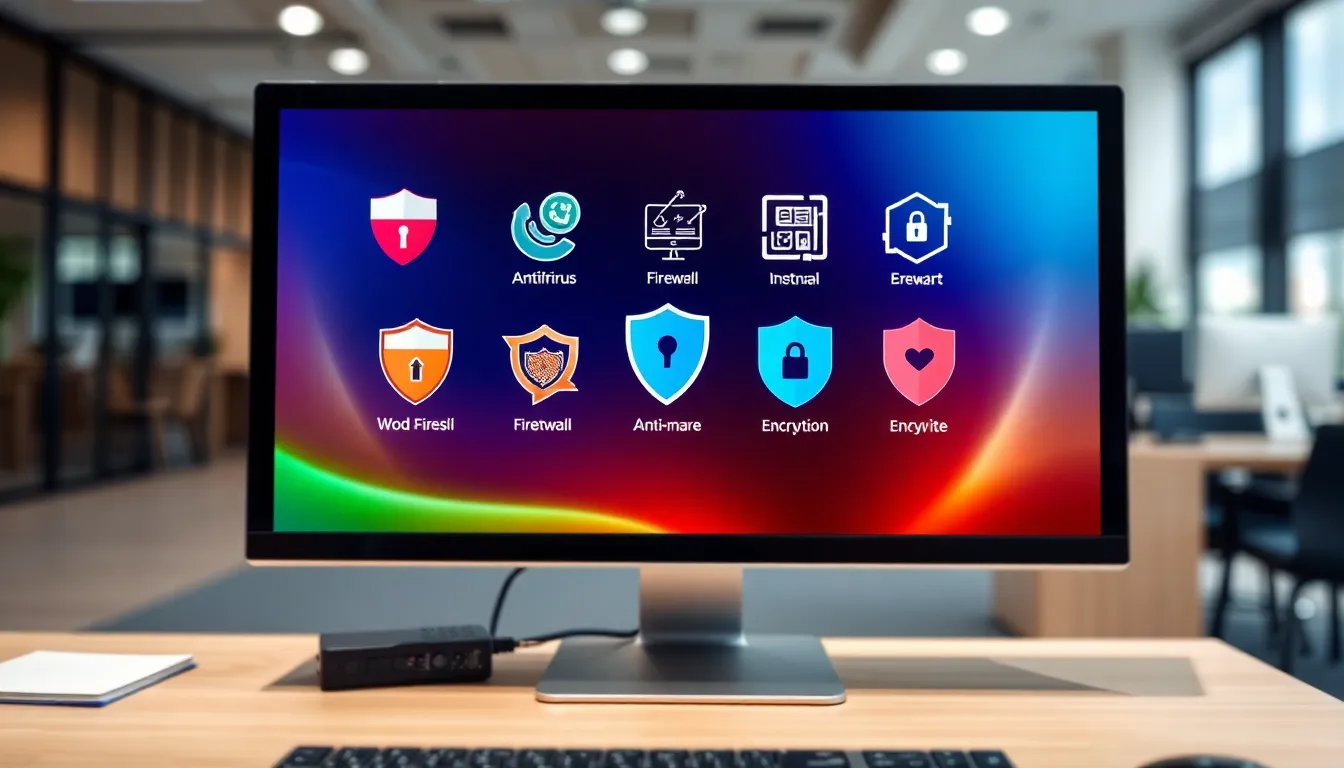In a world where cyber threats lurk around every digital corner, computer security software is like a superhero cape for your devices. It swoops in to protect your precious data from the villains of the internet—viruses, malware, and those pesky phishing scams that seem to pop up like weeds in a garden. Without it, your computer is as vulnerable as a cat at a dog park.
Table of Contents
ToggleOverview of Computer Security Software
Computer security software plays a vital role in protecting devices against cyber threats. It safeguards against viruses, malware, and phishing scams. Users benefit from real-time scanning that detects malicious activity before it compromises systems.
Antivirus software remains one of the most common types of security software. This software recognizes and neutralizes harmful programs, minimizing risks associated with downloads and browsing.
Anti-malware tools serve to complement antivirus solutions. They focus specifically on detecting and removing malware, which includes spyware, adware, and ransomware. A well-rounded approach involves using both antivirus and anti-malware solutions for comprehensive protection.
Firewalls are another essential component of computer security software. They monitor incoming and outgoing network traffic, establishing a barrier between a trusted internal network and untrusted external networks. This control prevents unauthorized access and potential attacks.
Security suites combine multiple security functions into one comprehensive package. These suites often include antivirus, anti-malware, firewalls, and even features like password management. Bundling offers users an all-in-one solution for their protection needs.
Updates play a crucial role in maintaining software effectiveness. It’s important that users keep security software updated to guard against emerging threats. Regular updates patch vulnerabilities, ensuring software remains armed against the latest cyber risks.
Investing in computer security software is essential for anyone using a computer in today’s digital landscape. The risks associated with unprotected systems can lead to significant data loss and financial consequences.
Types of Computer Security Software

Various types of computer security software protect devices from evolving cyber threats. Each software type serves a specific purpose within the broader landscape of digital security.
Antivirus Software
Antivirus software detects and neutralizes harmful programs. It scans files for known viruses and quarantines suspicious items. Users benefit from real-time protection against threats, reducing the likelihood of infection. Many antivirus solutions also include features such as email scanning and web protection to bolster security. Regular updates ensure the software recognizes the latest virus definitions, enhancing protection effectiveness.
Firewall Software
Firewall software monitors and controls incoming and outgoing network traffic. It acts as a barrier between trusted internal networks and untrusted external ones. Users can customize settings to block harmful data packets, effectively preventing unauthorized access. Some firewalls provide additional features, like intrusion detection and prevention systems, enhancing overall security. Configuring firewall software properly is crucial to maintaining a secure network environment.
Anti-Malware Software
Anti-malware software specifically targets malicious software like spyware, adware, and ransomware. This type of software offers advanced scanning capabilities to detect hidden threats. Users gain peace of mind with dedicated protection against a wide range of malicious programs. Many solutions provide automatic removal of detected malware, ensuring systems remain clean. Frequent updates keep the software well-equipped to handle new threats.
Encryption Software
Encryption software protects sensitive data by converting it into unreadable formats. It ensures that only authorized users can access information. Files, emails, and even entire drive partitions can be encrypted for added security. With strong encryption methods, data breaches become significantly less impactful. Implementing encryption software is essential for anyone handling confidential information to maintain privacy and protection.
Key Features to Consider
Selecting the right computer security software involves identifying several key features that enhance protection and usability. Users should prioritize the following aspects:
Real-Time Protection
Real-time protection is essential for immediate threat detection. This feature continuously monitors system activity, identifying suspicious behavior and promptly blocking potential threats. Sophisticated algorithms enable software to recognize new malware variants, ensuring comprehensive coverage. Regular updates further refine detection capabilities, keeping systems secure against evolving cyber threats. For optimal safety, selecting security software that offers robust real-time protection aids in preventing damage before it occurs.
User-Friendliness
User-friendliness plays a crucial role in ensuring effective use of security software. Intuitive interfaces enable users to navigate settings easily, customize security features, and access essential tools with minimal effort. Well-organized dashboards present important information without overwhelming users. Software with guided setup processes can significantly reduce technical barriers, allowing users of all skill levels to implement security measures efficiently. Prioritizing user-friendliness enhances engagement and encouragement to adopt necessary security practices.
System Compatibility
System compatibility is vital when choosing computer security software. Diverse operating systems and hardware configurations require security solutions that function seamlessly across platforms. Check for compatibility with existing devices and ensure the software supports essential features like automatic updates. Users benefit from selecting software that runs efficiently without hindering system performance. Favoring security solutions that accommodate various environments helps maintain optimal computer functionality while providing necessary protection.
Best Practices for Using Computer Security Software
Adhering to best practices enhances the effectiveness of computer security software. Users can significantly improve their protection against cyber threats through consistent actions.
Regular Updates
Keeping software updated is crucial. Software developers release updates to patch vulnerabilities and improve features. By enabling automatic updates, users ensure they receive the latest protection without manual intervention. Cyber threats evolve rapidly, so using outdated software increases risk. Regularly updated security programs offer new definitions and defenses against the latest security threats. Users can rely on these timely updates to safeguard systems effectively.
Scheduled Scans
Conducting scheduled scans helps maintain system integrity and device performance. Setting up scans on a regular basis ensures that malware or threats aren’t overlooked. Users can select daily, weekly, or monthly intervals based on their usage patterns. Automated scans reduce the chance of human error and provide peace of mind. Scanning at off-peak times optimizes resource allocation, preventing disruption during critical tasks. Following this practice allows users to identify and eliminate potential threats proactively.
Investing in computer security software is non-negotiable in today’s digital world. With cyber threats becoming increasingly sophisticated it’s crucial to have robust protection in place. Users should prioritize software that offers real-time protection and regular updates to stay ahead of potential risks.
Selecting the right security solution can make all the difference. By considering features like user-friendliness and system compatibility users can ensure they’re making informed choices. Implementing best practices such as enabling automatic updates and conducting regular scans can further enhance security measures.
Ultimately maintaining a secure digital environment is essential for safeguarding personal and sensitive information. By taking proactive steps users can effectively protect themselves from the ever-evolving landscape of cyber threats.




